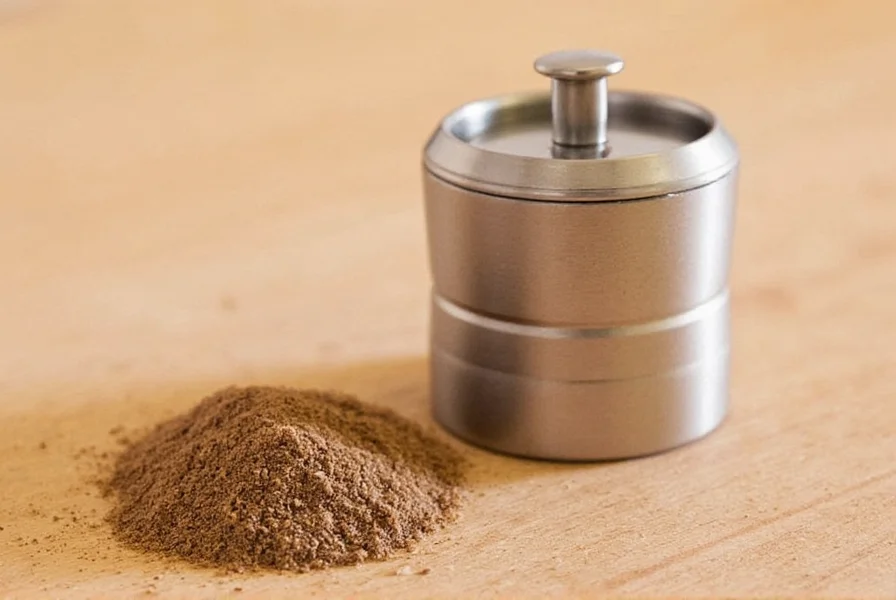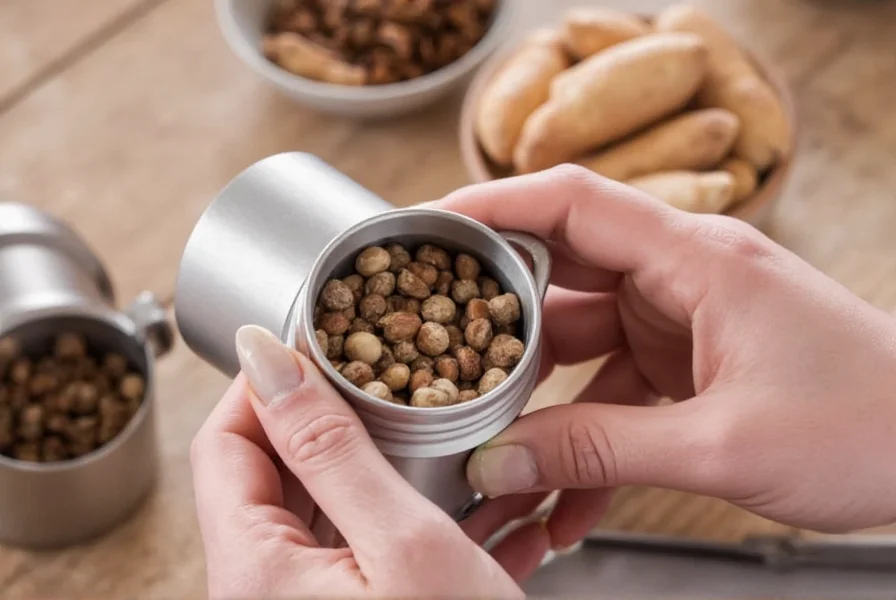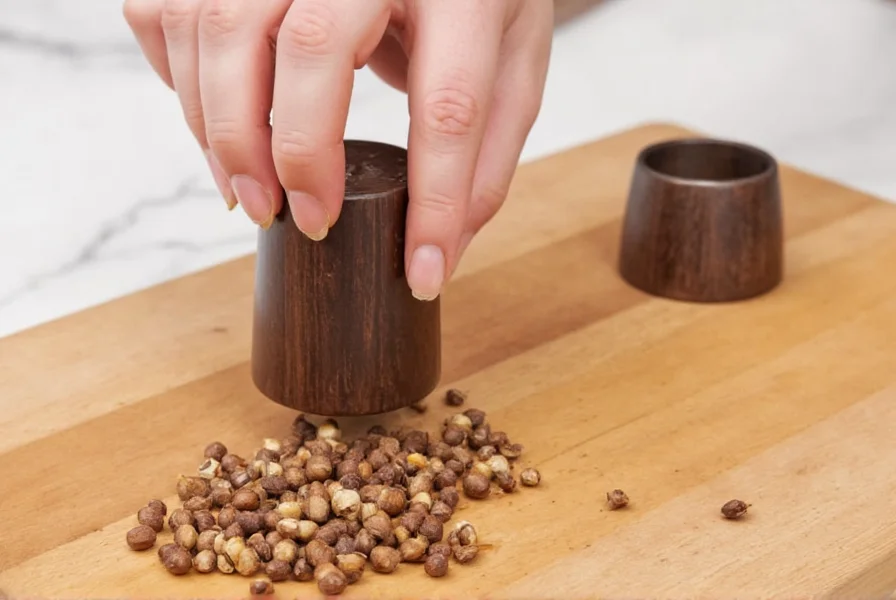Whole nutmeg offers significantly better flavor than pre-ground alternatives, but its rock-hard texture requires specialized equipment. Standard pepper mills and spice grinders often fail with nutmeg, clogging or producing uneven results. Understanding the right tool for this unique spice makes all the difference in culinary applications from béchamel sauce to pumpkin pie.
Why Nutmeg Requires a Specialized Grinder
Nutmeg's density (measuring 2.2-2.4 on the Mohs hardness scale) exceeds most other spices. This exceptional hardness demands grinding mechanisms specifically engineered to handle it without damaging the grinder or compromising flavor. When you use a dedicated nutmeg grinder, you preserve the delicate essential oils that give fresh nutmeg its complex aroma profile—notes of pine, citrus, and warmth that disappear within hours of grinding.
Pre-ground nutmeg loses up to 70% of its volatile oils within two weeks of grinding, according to food science research. A quality nutmeg grinder solves this problem by allowing you to grind only what you need, precisely when you need it.
Types of Nutmeg Grinders Compared
| Type | Best For | Grinding Mechanism | Maintenance Needs | Price Range |
|---|---|---|---|---|
| Traditional Manual | Daily home use | Hardened steel burr | Occasional brushing | $15-$40 |
| Adjustable Manual | Chefs needing precision | Ceramic or steel burr | Regular cleaning | $25-$60 |
| Electric Nutmeg Grinder | High-volume use | Stainless steel blades | Disassembly required | $35-$80 |
| Multi-Spice Grinder | Occasional nutmeg use | Steel blades | Thorough cleaning between spices | $20-$50 |
Key Features to Consider When Choosing
When selecting the best nutmeg grinder for your kitchen, focus on these critical elements that affect performance and longevity:
Grinding Mechanism Material
Hardened steel and ceramic represent the two premium options. Steel mechanisms offer durability and consistent performance but may slightly alter flavor over time. Ceramic mechanisms preserve pure flavor and resist corrosion but require more careful handling. Avoid plastic mechanisms—they quickly wear down when grinding hard nutmeg seeds.
Adjustability
Higher-end manual grinders feature adjustable grind settings. This allows you to control particle size from fine powder for sauces to coarser grinds for garnishes. The adjustment mechanism should feel precise and maintain settings through regular use.
Capacity and Design
Traditional nutmeg grinders hold one whole nut (about 1-1.5 inches). Larger capacity models exist but often compromise on grinding efficiency. Look for ergonomic designs that provide comfortable grip during grinding—especially important since nutmeg requires more force than peppercorns.
Proper Usage Techniques
How you use your nutmeg grinder significantly impacts results. Follow these professional techniques:
- Store nutmeg properly—Keep whole seeds in an airtight container away from light and moisture to preserve oils
- Use the right amount of pressure—Apply firm, consistent downward pressure while twisting for even grinding
- Grind in short bursts—Prevents overheating which can degrade flavor compounds
- Clean immediately after use—Nutmeg oil can harden and clog mechanisms if left uncleaned
For electric models, never leave the grinder running continuously—30-second intervals prevent motor strain and flavor degradation from heat buildup.
Maintenance Essentials
Proper care extends your nutmeg grinder's life and maintains flavor quality. Unlike pepper mills, nutmeg grinders require specific maintenance due to the sticky nature of nutmeg oils:
- After each use, run the grinder empty for 5-10 seconds to clear residual particles
- Monthly, disassemble (if possible) and brush mechanisms with a soft-bristled brush
- Never immerse electric models or wooden-bodied grinders in water
- For stubborn residue, use uncooked rice as a natural cleaning agent
Stainless steel nutmeg grinder models generally require less maintenance than wooden-handled versions, but both benefit from regular attention to preserve grinding performance.

Common Mistakes to Avoid
Even experienced cooks make these errors with nutmeg grinders:
- Using damp nutmeg seeds—Moisture causes clogging and mold growth
- Grinding too much at once—Overloading produces uneven texture and strains mechanisms
- Using for other hard spices—Cinnamon sticks or cloves can damage specialized mechanisms
- Ignoring adjustment settings—Using the same setting for all applications limits versatility
Remember that fresh ground nutmeg loses potency quickly—grind immediately before use for maximum flavor impact in your dishes.
Why Fresh Ground Nutmeg Matters
The flavor difference between fresh ground and pre-ground nutmeg isn't subtle—it's transformative. Food scientists have identified over 150 aromatic compounds in whole nutmeg, with nearly half degrading within hours of grinding. A quality nutmeg grinder preserves these compounds until the moment of use, delivering:
- Noticeably brighter citrus notes
- More complex warm spice profile
- Longer-lasting flavor in finished dishes
- Reduced bitterness compared to pre-ground versions
Professional chefs consistently report that dishes made with freshly ground nutmeg require 30-40% less spice to achieve the same flavor impact, demonstrating the superior concentration of active compounds.

Frequently Asked Questions
Can I use a pepper mill for nutmeg?
Standard pepper mills typically clog when used for nutmeg due to its extreme hardness and oily nature. While some adjustable mills claim multi-spice functionality, dedicated nutmeg grinders with hardened steel or ceramic mechanisms provide significantly better performance and longevity for this specific spice.
How long does a whole nutmeg seed stay fresh?
When stored properly in an airtight container away from light and moisture, whole nutmeg seeds maintain optimal flavor for 2-3 years. This extended shelf life compared to pre-ground nutmeg (which loses significant flavor within weeks) is a key reason why using a dedicated nutmeg grinder provides superior results.
What's the difference between manual and electric nutmeg grinders?
Manual nutmeg grinders offer more precise control over grind size and generate less heat, preserving delicate flavor compounds. Electric models provide convenience for frequent use but can generate heat that degrades flavor if overused. For most home kitchens, a high-quality manual grinder provides the best balance of performance, flavor preservation, and ease of use.
Why does my nutmeg grinder keep clogging?
Clogging usually occurs when nutmeg seeds contain moisture, when the grinder isn't cleaned properly after use, or when using a grinder with an inappropriate mechanism for nutmeg's hardness. Ensure seeds are completely dry before grinding, clean the mechanism after each use, and verify you're using a grinder specifically designed for nutmeg rather than a general spice grinder.
How do I clean a nutmeg grinder without damaging it?
For manual grinders, run uncooked rice through the mechanism to absorb oils, then brush out residue with a soft-bristled brush. Never submerge the grinding mechanism in water. For stubborn buildup, disassemble if possible and wipe components with a lightly dampened cloth, then dry thoroughly before reassembling. Electric models require following manufacturer-specific cleaning instructions to avoid damaging electrical components.











 浙公网安备
33010002000092号
浙公网安备
33010002000092号 浙B2-20120091-4
浙B2-20120091-4